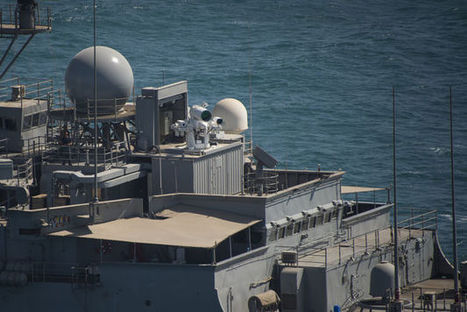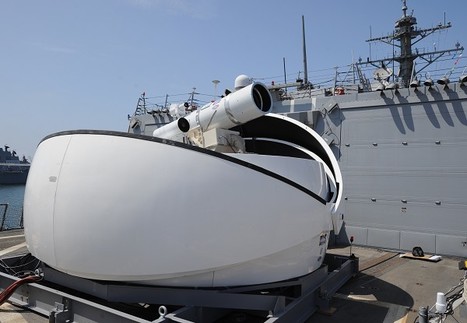The Afloat Forward Staging Base (Interim) USS Ponce (ASB(I) 15) conducts an operational demonstration of the Office of Naval Research (ONR)-sponsored Laser Weapon System (LaWS) while deployed to the Arabian Gulf.
Get Started for FREE
Sign up with Facebook Sign up with X
I don't have a Facebook or a X account

 Your new post is loading... Your new post is loading...
Current selected tag: 'LaWS'. Clear
The U.S. Navy has deployed on a command ship in the Persian Gulf its first laser weapon capable of destroying a target. The amphibious transport ship USS Ponce has been patrolling with a prototype 30-kilowatt-class Laser Weapon System since late August, according to officials. The laser is mounted facing the bow, and can be fired in several modes -- from a dazzling warning flash to a destructive beam -- and can set a drone or small boat on fire. The Ponce “provides a unique platform” to deploy the new capability “in an operationally relevant region,” Vice Admiral John Miller, the 5th Fleet commander, said in an e-mailed statement. The ship is the 5th Fleet’s primary command and control afloat staging base for operations Since 2011, the Navy has boosted its presence in the Persian Gulf and the Strait of Hormuz, through which a fifth of the world’s traded oil flows. Equipped with naval mines and small vessels that practice swarming tactics to attack larger warships, Iranian officials have periodically threatened to close the waterway. Naval Sea Systems Command technicians developed the prototype over seven years at a cost of about $40 million. The Ponce crew was authorized to deploy the weapon after it passed a series of at-sea tests, including lasing static surface targets, the 5th Fleet spokesman Commander Kevin Stephens said in an e-mail statement. The prototype focuses the light from six solid-state commercial welding lasers on a single spot, according to a July 31 Congressional Research Service report. It “can effectively counter surface and airborne threats, to include small boats” and drones, Miller said, and firing it costs about a dollar a shot, according to the Navy. Adjustable Strength The device can emit progressively stronger beams, first to warn an adversary, and then destroy it if necessary, Chief of Naval Research Rear Admiral Matthew Klunder said at a Bloomberg Government session this year. The laser can be adjusted to fire a non-lethal dazzling flash at an incoming vessel so they know it’s there “all the way to lethal,” Klunder said. The laser’s range is classified. New York-based L-3 Communications Holdings LLC and Pennsylvania State University’s Electro Optics Center have provided components and engineering support. The lessons from the one-year Ponce deployment will feed Navy laser development by industry teams led by BAE Systems Plc, Northrop Grumman Corp. and Raytheon Co., to field a more powerful weapon, possibly by 2021. |
Officials at the Office of Naval Research (ONR) announced December 10th the laser weapon system (LaWS) - a cutting-edge weapon that brings significant new capabilities to America's Sailors and Marines - was for the first time successfully deployed and operated aboard a naval vessel in the Arabian Gulf. The operational demonstrations, which took place from September to November aboard USS Ponce (AFSB[I] 15), were historic not only because they showed a laser weapon working aboard a deployed U.S. Navy ship, but also because LaWS operated seamlessly with existing ship defense systems. The system is operated by a video-game like controller, and can address multiple threats using a range of escalating options, from non-lethal measures such as optical "dazzling" and disabling, to lethal destruction if necessary. It could prove to be a pivotal asset against what are termed "asymmetric threats," which include small attack boats and UAVs.
Patrick H. 's insight:
Le système étant déclaré opérationnel, le commandant de l'USS Ponce est autorisé à l'utiliser en auto-défense : http://news.usni.org/2014/12/10/u-s-navy-allowed-use-persian-gulf-laser-defense
Le système d'armes laser (LaWS) est prêt pour son déploiement dans le Golfe Persique sur l'USS PonceNavy engineers are making final adjustments to a laser weapon prototype that will be the first of its kind to deploy aboard a ship late this summer. The prototype, an improved version of the Laser Weapon System (LaWS), will be installed on USS Ponce for at-sea testing in the Persian Gulf, fulfilling plans announced by Chief of Naval Operations Adm. Jonathan Greenert at the 2013 Sea-Air-Space Expo. Navy leaders have made directed-energy weapons a top priority to counter what they call asymmetric threats, including unmanned and light aircraft and small attack boats that could be used to deny U.S. forces access to certain areas. High-energy lasers offer an affordable and safe way to target these threats at the speed of light with extreme precision and an unlimited magazine, experts say. "Our nation's adversaries are pursuing a variety of ways to try and restrict our freedom to operate," Klunder said. "Spending about $1 per shot of a directed-energy source that never runs out gives us an alternative to firing costly munitions at inexpensive threats." Klunder leads the Office of Naval Research (ONR), which has worked with the Naval Sea Systems Command, Naval Research Laboratory, Naval Surface Warfare Center Dahlgren Division and others to make powerful directed-energy weapons a reality. The Navy already has demonstrated the effectiveness of lasers in a variety of maritime settings. In a 2011 demonstration, a laser was used to defeat multiple small boat threats from a destroyer. In 2012, LaWS downed several unmanned aircraft in tests. Over the past several months, working under the ONR Quick Reaction Capability program, a team of Navy engineers and scientists have upgraded LaWS, and proved that targets tracked with a Phalanx Close-In Weapon can be easily handed over to the laser's targeting and tracking system. The result is a weapon system with a single laser weapon control console, manned by a surface warfare weapons officer aboard USS Ponce who can operate all functions of the laser-and if commanded, fire the laser weapon. Using a video game-like controller, that sailor will be able to manage the laser's power to accomplish a range of effects against a threat, from disabling to complete destruction. The deployment on Ponce will prove crucial as the Navy continues its push to provide laser weapons to the fleet at large. Data regarding accuracy, lethality and other factors from the Ponce deployment will guide the development of even more capable weapons under ONR's Solid-State Laser - Technology Maturation program. Under this program, industry teams led by Northrop Grumman, BAE Systems and Raytheon Corp. have been selected to develop cost-effective, combat-ready laser prototypes that could be installed on vessels such as guided-missile destroyers and the Littoral Combat Ship in 2016. The Navy will decide next year which, if any, of the three industry prototypes are suitable to move forward and begin initial ship installation for further testing. |












Pour en savoir plus sur le LaWS et les systèmes d'armes Laser en développement chez les américains :
http://fas.org/sgp/crs/weapons/R41526.pdf